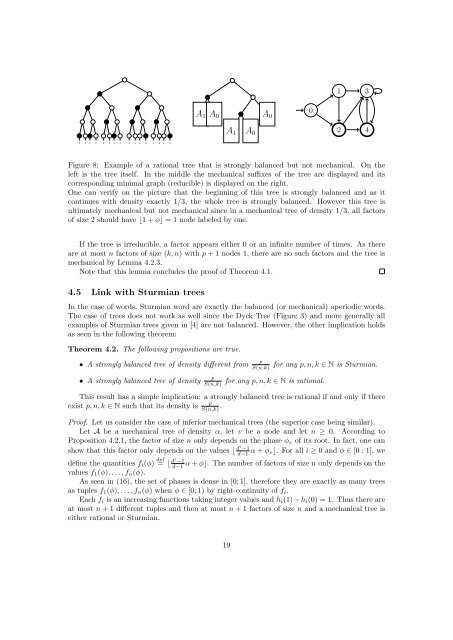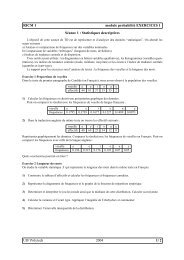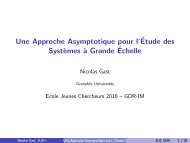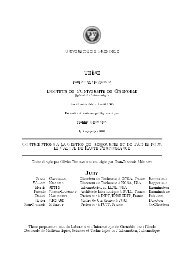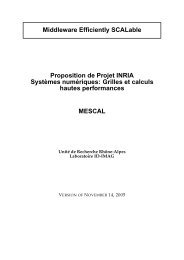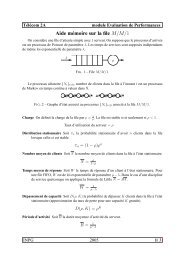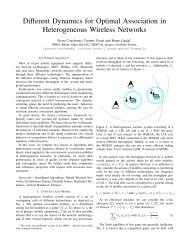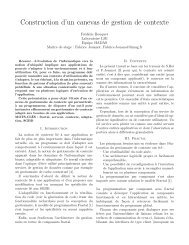Distributing labels on infinite trees
Distributing labels on infinite trees
Distributing labels on infinite trees
You also want an ePaper? Increase the reach of your titles
YUMPU automatically turns print PDFs into web optimized ePapers that Google loves.
13A 1 A 0A 1 A 0A 0024Figure 8: Example of a rati<strong>on</strong>al tree that is str<strong>on</strong>gly balanced but not mechanical. On theleft is the tree itself. In the middle the mechanical suffixes of the tree are displayed and itscorresp<strong>on</strong>ding minimal graph (reducible) is displayed <strong>on</strong> the right.One can verify <strong>on</strong> the picture that the beginning of this tree is str<strong>on</strong>gly balanced and as itc<strong>on</strong>tinues with density exactly 1/3, the whole tree is str<strong>on</strong>gly balanced. However this tree isultimately mechanical but not mechanical since in a mechanical tree of density 1/3, all factorsof size 2 should have ⌊1 + φ⌋ = 1 node labeled by <strong>on</strong>e.If the tree is irreducible, a factor appears either 0 or an <strong>infinite</strong> number of times. As thereare at most n factors of size (k, n) with p + 1 nodes 1, there are no such factors and the tree ismechanical by Lemma 4.2.3.Note that this lemma c<strong>on</strong>cludes the proof of Theorem 4.1.4.5 Link with Sturmian <strong>trees</strong>In the case of words, Sturmian word are exactly the balanced (or mechanical) aperiodic words.The case of <strong>trees</strong> does not work as well since the Dyck Tree (Figure 3) and more generally allexamples of Sturmian <strong>trees</strong> given in [4] are not balanced. However, the other implicati<strong>on</strong> holdsas seen in the following theorem:Theorem 4.2. The following propositi<strong>on</strong>s are true.• A str<strong>on</strong>gly balanced tree of density different from• A str<strong>on</strong>gly balanced tree of densitypS(n,k)pS(n,k)for any p, n, k ∈ N is Sturmian.for any p, n, k ∈ N is rati<strong>on</strong>al.This result has a simple implicati<strong>on</strong>: a str<strong>on</strong>gly balanced tree is rati<strong>on</strong>al if and <strong>on</strong>ly if thereexist p, n, k ∈ N such that its density ispS(n,k) .Proof. Let us c<strong>on</strong>sider the case of inferior mechanical <strong>trees</strong> (the superior case being similar).Let A be a mechanical tree of density α, let v be a node and let n ≥ 0. According toPropositi<strong>on</strong> 4.2.1, the factor of size n <strong>on</strong>ly depends <strong>on</strong> the phase φ v of its root. In fact, <strong>on</strong>e canshow that this factor <strong>on</strong>ly depends <strong>on</strong> the values ⌊ di −1d−1 α + φ v⌋. For all i ≥ 0 and φ ∈ [0 : 1], wedefine the quantities f i (φ) def= ⌊ di −1d−1α + φ⌋. The number of factors of size n <strong>on</strong>ly depends <strong>on</strong> thevalues f 1 (φ), . . . , f n (φ).As seen in (16), the set of phases is dense in [0; 1], therefore they are exactly as many <strong>trees</strong>as tuples f 1 (φ), . . . , f n (φ) when φ ∈ [0; 1) by right-c<strong>on</strong>tinuity of f i .Each f i is an increasing functi<strong>on</strong>s taking integer values and h i (1) − h i (0) = 1. Thus there areat most n + 1 different tuples and then at most n + 1 factors of size n and a mechanical tree iseither rati<strong>on</strong>al or Sturmian.19


